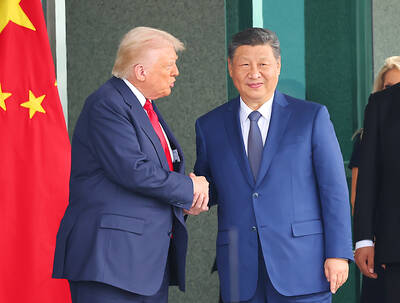Passive-component supplier Yageo Corp (國巨) yesterday saw its stock rally nearly 4 percent amid expectations that the stock would extend its uptrend through the end of the year and speculation that China’s latest curb on toxic emissions would limit production of raw materials for passive components, thereby reducing their supply.
Shares of Yageo leaped 3.82 percent to NT$843, making it the second-most traded stock by value after Taiwan Semiconductor Manufacturing Co (TSMC, 台積電), Taiwan Stock Exchange data showed.
Shares of local rival Walsin Technology Corp (華新科技) soared 7.41 percent to NT$369.5 yesterday, while the TAIEX edged up 0.14 percent.
A total of NT$11.45 billion (US$373.6 million) of Yageo shares changed hands yesterday, the tally showed, as more signs indicated that the price hikes for passive components might not come to an end this year.
Yageo has forecast that it could reach full capacity utilization over the next two years given strong customer demand.
On the supply side, the government of Chaoqing City in China’s Guangdong Province ordered all ceramic electric powder suppliers with operations in the city to slash production by 50 percent, beginning on Sunday last week, in the local government’s latest crackdown on toxic emissions, Tencent Holdings Ltd’s (騰訊) news app Tian Tian Kuai Bao (天天快報) reported earlier this month.
The factories were told to fully shut down their factories through early October, the report said.
The scale-down in the production of raw material used in passive components, multilayer ceramic capacitors (MLCC) and chip resistors is expected to further squeeze an already-tight supply of passive components, boosting their prices, the report said.
The order came as it aimed to reduce environmental pollution during a major sports event held by the city government next month, the report said.
A Japanese investment consultancy last week raised the target prices of major Japanese MLCC manufacturers, including Murata Manufacturing Co, Taiyuo Yuten Co and TDK Corp.
It increased the target price of Murata to ¥25,000 from a previous estimate of ¥18,500, as strong demand pushed up MLCC exports 45 percent year-on-year in May, according to the consultancy.
Murata was reportedly in talks with clients to hike MLCC prices by 20 to 30 percent, which would boost the company’s financial performance for the remainder of the year, it said.
Taiyuo Yuten and TDK also saw their target prices raised to ¥4,000 and ¥13,000, from ¥2,800 and ¥10,500 respectively.

Nissan Motor Co has agreed to sell its global headquarters in Yokohama for ¥97 billion (US$630 million) to a group sponsored by Taiwanese autoparts maker Minth Group (敏實集團), as the struggling automaker seeks to shore up its financial position. The acquisition is led by a special purchase company managed by KJR Management Ltd, a Japanese real-estate unit of private equity giant KKR & Co, people familiar with the matter said. KJR said it would act as asset manager together with Mizuho Real Estate Management Co. Nissan is undergoing a broad cost-cutting campaign by eliminating jobs and shuttering plants as it grapples

TEMPORARY TRUCE: China has made concessions to ease rare earth trade controls, among others, while Washington holds fire on a 100% tariff on all Chinese goods China is effectively suspending implementation of additional export controls on rare earth metals and terminating investigations targeting US companies in the semiconductor supply chain, the White House announced. The White House on Saturday issued a fact sheet outlining some details of the trade pact agreed to earlier in the week by US President Donald Trump and Chinese President Xi Jinping (習近平) that aimed to ease tensions between the world’s two largest economies. Under the deal, China is to issue general licenses valid for exports of rare earths, gallium, germanium, antimony and graphite “for the benefit of US end users and their suppliers

Dutch chipmaker Nexperia BV’s China unit yesterday said that it had established sufficient inventories of finished goods and works-in-progress, and that its supply chain remained secure and stable after its parent halted wafer supplies. The Dutch company suspended supplies of wafers to its Chinese assembly plant a week ago, calling it “a direct consequence of the local management’s recent failure to comply with the agreed contractual payment terms,” Reuters reported on Friday last week. Its China unit called Nexperia’s suspension “unilateral” and “extremely irresponsible,” adding that the Dutch parent’s claim about contractual payment was “misleading and highly deceptive,” according to a statement

The Chinese government has issued guidance requiring new data center projects that have received any state funds to only use domestically made artificial intelligence (AI) chips, two sources familiar with the matter told Reuters. In recent weeks, Chinese regulatory authorities have ordered such data centers that are less than 30 percent complete to remove all installed foreign chips, or cancel plans to purchase them, while projects in a more advanced stage would be decided on a case-by-case basis, the sources said. The move could represent one of China’s most aggressive steps yet to eliminate foreign technology from its critical infrastructure amid a